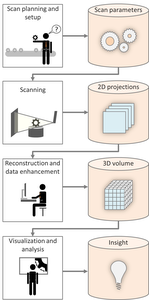Information
- Publication Type: PhD-Thesis
- Workgroup(s)/Project(s): not specified
- Date: November 2012
- TU Wien Library:
- Second Supervisor: Christoph Heinzl
- 1st Reviewer: Klaus Mueller
- Rigorosum: 8. November 2012
- First Supervisor: Eduard Gröller
Abstract
Three-dimensional X-ray computed tomography (3DXCT) is a powerful technique for generating a digital 3D volumetric representation of a specimen from a series of 2D X-ray penetration images. The main advantage of 3DXCT is its ability to detect both the interior and the exterior structure of a specimen in one single scan. Having been used in medical diagnostics for a long time, 3DXCT is increasingly employed in industry as a method for nondestructive testing and quality control. One especially challenging industrial application is metrology, which has to fulfill the demands of today’s standards in industrial quality control. 3DXCT facilitates dimensional measurements of internal structures and of inaccessible parts of a component. However the successful industrial application of 3DXCT is constrained by a set of major problems: Artifacts: Industrial 3DXCT systems face problems due to various types of artifacts. The appearance of artifacts in the 3DXCT scan data distorts its correlation to the actual evaluated industrial object and can lead to errors in measurements and false analysis results. Some types of artifacts are affected by the placement of a specimen in the scanning device. Multi-material components: Another problem is occurring when multi-material components (MMCs) are inspected using industrial 3DXCT. Common industrial MMCs may contain metal parts surrounded by plastic materials. A major problem of this type of components is the presence of metal-caused streaking artifacts and distortions. They are located around metal components and significantly influence the material characterization. Furthermore these streaking artefacts and distortions may even prevent any further analysis (especially for the plastic components). Measurements uncertainty: If metrology using 3DXCT is performed, the location of the specimen surface is estimated using the reconstructed 3D volume data. As opposed to mechanical or optical measurement techniques, the surface is not explicit and has a particular positional uncertainty depending on the artifacts and noise in the scan data and the surface extraction algorithm. Conventional CT metrology software does not account for the uncertainty of the data. This thesis is devoted to the development of techniques overcoming the aforementioned problems of common industrial tasks involving the usage of 3DXCT for nondestructive testing and quality control with a main focus on industrial 3DXCT metrology. Several novel contributions utilizing visualization techniques and visual analysis methods were implemented in integrated tools assisting typical industrial 3DXCT tasks during different stages of the data pipeline.Additional Files and Images
Weblinks
No further information available.BibTeX
@phdthesis{amirkhanov-2012-thesis,
title = "Visualization of Industrial 3DXCT Data",
author = "Artem Amirkhanov",
year = "2012",
abstract = "Three-dimensional X-ray computed tomography (3DXCT) is a
powerful technique for generating a digital 3D volumetric
representation of a specimen from a series of 2D X-ray
penetration images. The main advantage of 3DXCT is its
ability to detect both the interior and the exterior
structure of a specimen in one single scan. Having been used
in medical diagnostics for a long time, 3DXCT is
increasingly employed in industry as a method for
nondestructive testing and quality control. One especially
challenging industrial application is metrology, which has
to fulfill the demands of today’s standards in industrial
quality control. 3DXCT facilitates dimensional measurements
of internal structures and of inaccessible parts of a
component. However the successful industrial application of
3DXCT is constrained by a set of major problems: Artifacts:
Industrial 3DXCT systems face problems due to various types
of artifacts. The appearance of artifacts in the 3DXCT scan
data distorts its correlation to the actual evaluated
industrial object and can lead to errors in measurements and
false analysis results. Some types of artifacts are affected
by the placement of a specimen in the scanning device.
Multi-material components: Another problem is occurring when
multi-material components (MMCs) are inspected using
industrial 3DXCT. Common industrial MMCs may contain metal
parts surrounded by plastic materials. A major problem of
this type of components is the presence of metal-caused
streaking artifacts and distortions. They are located around
metal components and significantly influence the material
characterization. Furthermore these streaking artefacts and
distortions may even prevent any further analysis
(especially for the plastic components). Measurements
uncertainty: If metrology using 3DXCT is performed, the
location of the specimen surface is estimated using the
reconstructed 3D volume data. As opposed to mechanical or
optical measurement techniques, the surface is not explicit
and has a particular positional uncertainty depending on the
artifacts and noise in the scan data and the surface
extraction algorithm. Conventional CT metrology software
does not account for the uncertainty of the data. This
thesis is devoted to the development of techniques
overcoming the aforementioned problems of common industrial
tasks involving the usage of 3DXCT for nondestructive
testing and quality control with a main focus on industrial
3DXCT metrology. Several novel contributions utilizing
visualization techniques and visual analysis methods were
implemented in integrated tools assisting typical industrial
3DXCT tasks during different stages of the data pipeline.",
month = nov,
address = "Favoritenstrasse 9-11/E193-02, A-1040 Vienna, Austria",
school = "Institute of Computer Graphics and Algorithms, Vienna
University of Technology ",
URL = "https://www.cg.tuwien.ac.at/research/publications/2012/amirkhanov-2012-thesis/",
}


 dissertation
dissertation
